Hangul 소주 Revised Romanization Soju | Hanja 燒酒 McCune–Reischauer Sochu | |
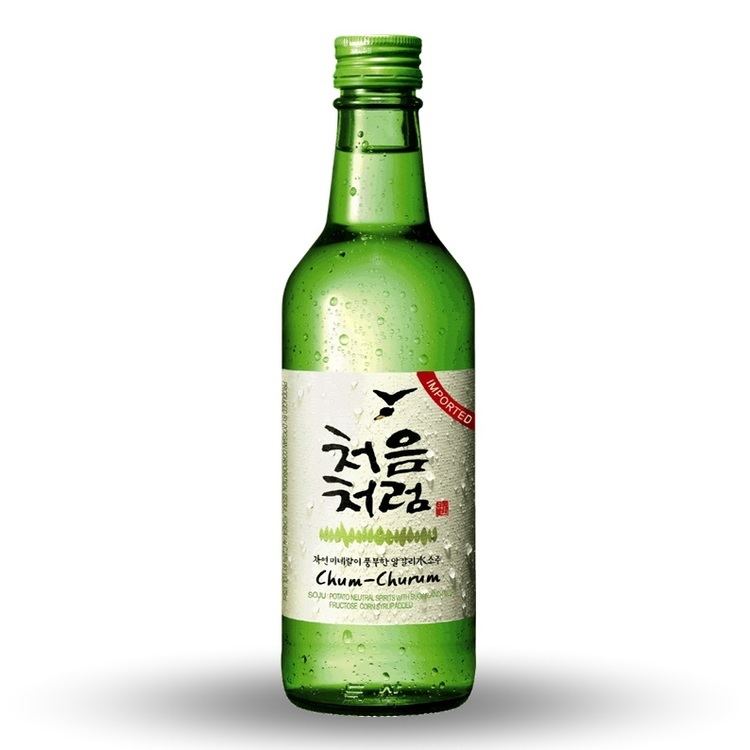 | ||
Similar | ||
Soju is korean firewater al kee hol
Soju ([sʰodʑu]; Hangul: 소주; Hanja: 燒酒) is a distilled beverage containing ethanol and water. It is usually consumed neat.
Contents
- Soju is korean firewater al kee hol
- Americans try flavored soju
- Production
- Etymology
- History
- Etiquette
- Korea
- South Korea
- China
- Canada
- United States
- Brands
- Consumption
- Cocktails
- References
Considered "Korea's most popular alcoholic beverage" in 2014 Jinro soju was the largest selling alcohol brand in the world with sales of 71 million cases worldwide. Most brands of soju are made in South Korea. While it is traditionally made from rice, wheat, or barley, modern producers often replace rice with other starches such as potatoes, sweet potatoes, or tapioca.
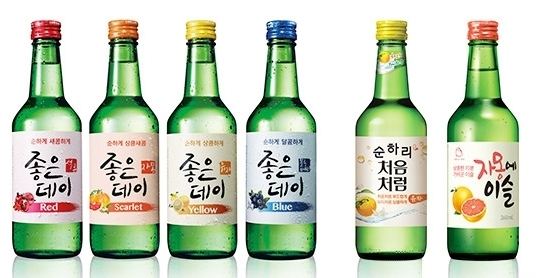
Americans try flavored soju
Production
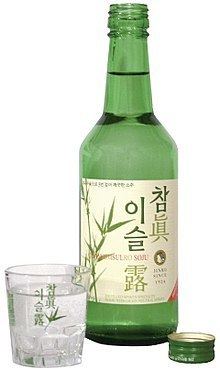
Soju is clear and colorless. Its alcohol content varies from about 18% to 45% alcohol by volume (ABV) for traditional Andong soju, with 20% ABV being most common. However, by using freeze distillation, ABV can be increased to the desired percentage.
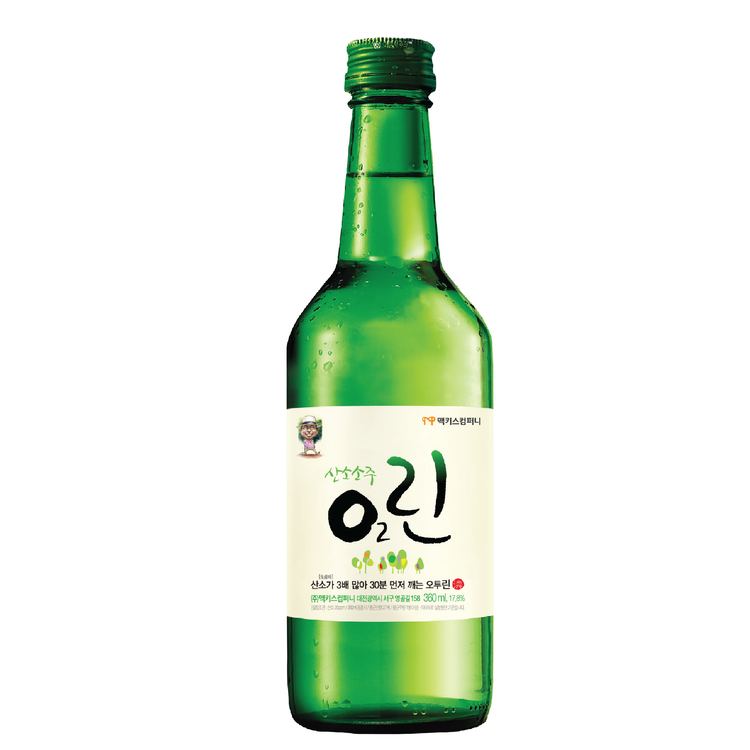
Soju is traditionally made by distilling alcohol from fermented grain. Modern soju manufacturers produce it by purchasing ethanol (95% ABV), diluting it with water and adding sweeteners. The end products are marketed under a variety of soju brand names. A single supplier (대한주정판매) sells ethanol to all soju producers in Korea. Until the late 1980s, saccharin was the most popular sweetener used by the industry, but it has since been replaced by stevioside.
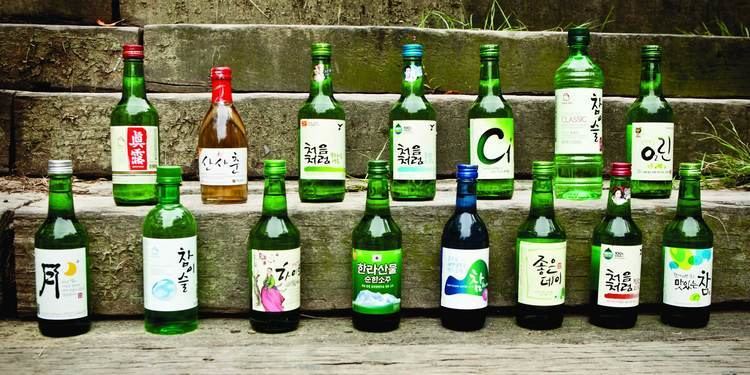
Distilled soju usually has 30–35% ABV, whereas soju from diluted ethanol may range from 21–30% ABV,. A typical 375 ml bottle of soju retails for 1,000 to 3,000 won ($0.88 to $2.65 USD). Soju is exported to 80 countries and is in the top market share of diluted alcohol market. Statistically, soju ranked number one in world sale records of the diluted alcohol market in 2002.
Etymology
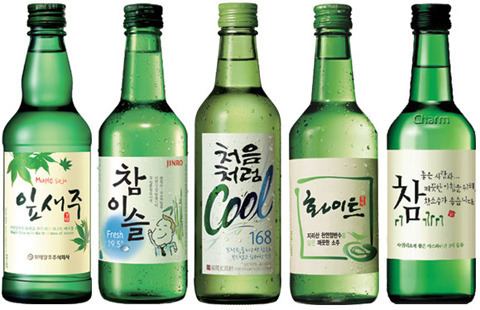
Soju (소주) literally means "burned alcoholic drink," referring to the heat of distillation. In 2008, the word "soju" was included in the Merriam-Webster Dictionary. Merriam-Webster dated the word's appearance in the American English lexicon at 1978.
History
Soju's origin is airag, a Levantine distilled alcoholic spirit. Mongolian forces that invaded Koryo in the 1300s conveyed the recipe of airag, and it developed into soju in Koryo. Soju was first created in Andong, where Mongolian troops were stationed. This is the root of Andong soju.
Etiquette
Koreans have very strict rules of etiquette in drinking soju. When receiving a glass from an elder, one must hold the glass with two hands (left palm at the bottom and hold the glass with the right hand) and bow the head slightly. When it is time to drink, the drinker must turn away from the elder, and cover the mouth and glass with their hands. The first drink must be finished in one shot. When the glass is empty, the drinker hands it back to the person who poured the drink for them and the drinker then pours them a shot. This starts a series of glass and bottle passes around the table.
Korea
Soju was first distilled around the 13th century, during the Mongol invasions of Korea. The Mongols had acquired the technique of distilling Arak from the Persians during their invasion of Central Asia and the Middle East around 1256. It was subsequently introduced to the Koreans, and distilleries were set up around the city of Kaesong. In the surrounding areas of Kaesong, soju is known as arak-ju (hangul: 아락주).
South Korea
From 1965 until 1999, in order to alleviate rice shortages, the South Korean government prohibited the traditional distillation of soju from rice. Instead, soju was created using highly distilled ethanol from sweet potatoes and tapioca, which was mixed with flavorings, and sweeteners, and water. Although the prohibition has been lifted, cheap soju continues to be made this way. The South Korean government regulates the alcohol content of diluted soju to less than 35%, but alcohol levels have continued to fall in order to reduce production costs. The lower alcohol concentration also makes the drink milder to consume, which may broaden its appeal.
Several regions have resumed distilling soju from grain. Soju from Andong, South Korea is a traditional hand-crafted soju that has about 45% ABV. Hwayo (화요) is another brand with five different mixes constituting an ABV range from 17% to 53%.
China
There are a number of soju brands directly outside the Korean Peninsula for the ethnic Korean population, and most use rice as the foundation since the price is significantly cheaper than in South Korea. Soju from North and South Korea, from firms like Jinro, is also imported.
Canada
Liquors in Canada are subject to regulations that vary from province to province. In Ontario, the provincially run Liquor Control Board of Ontario (LCBO) sells soju, but not all outlets carry it. The LCBO sells a variable number of different kinds of soju, there are usually 3 or 4 different brands carried in the system at all times. Not all LCBO locations have soju,since the LCBO introduced online ordering it can be ordered for home delivery anywhere in the province. Almost all Korean restaurants with an AGCO liquor license sell it.
In other Canadian provinces liquor sales may be privatized or semi-privatized. In Alberta, for example, a liquor store may carry dozens of brands of Soju.
United States
The liquor licensing laws in the states of California and New York specifically exempt the sale of soju from regulation relating to the sale of other distilled spirits, allowing businesses with a beer/wine license to sell it without requiring the more expensive license required for other distilled spirits. The only stipulation is that the soju must be clearly labeled as such and contain less than 25% alcohol. This has led to the appearance in the United States of many soju-based equivalents of traditional Western mixed drinks normally based on vodka or similar spirits, such as the soju martini and the soju cosmopolitan. Another consequence is that the manufacturers of similar distilled spirits from other parts of Asia, such as Japanese shōchū, have begun to re-label their products as soju for sale in those regions. Jinro's American division has partnered with Korean pop star PSY to promote Soju in the U.S., and in 2013 partnered with the Los Angeles Dodgers to sell Soju at its games.
Brands
Jinro is the largest manufacturer of soju accounting for half of all white spirits sold in South Korea. Soju accounts for 97% of the category. Global sales in 2013 were 750 million bottles; the second-largest spirits brand, Smirnoff, sold less than half that number. The most popular variety of soju is currently Jinro (참이슬 - literally meaning "real dew"), a quadruple-filtered soju produced by Jinro, but recently Cheoeum-Cheoreom (처음처럼, lit. "like the first time") of Lotte Chilsung (롯데칠성) and Good Day (좋은데이) of Muhak (무학) are increasing their market share. However, the popularity of brands varies by region. In Busan, C1 Soju (시원 소주) is the local and most popular brand. Ipsaeju (잎새주 - "leaf alcohol") is popular in the Jeollanam-do region. The Daegu Metropolitan Area has its own soju manufacturer, Kumbokju, with the popular brand Cham (참). Further north in the same province, Andong Soju is one of Korea's few remaining traditionally distilled brands of soju. On the Special Self-Governing Province of Jeju-do, Hallasan Soju is the most common brand, being named after the island's main mountain Mt. Halla. In Gyeongsangnam-do and Ulsan, the most popular is Good Day (Hangul: 좋은데이), produced by Muhak in Changwon. However, as soon as one crosses the border from Ulsan north to Gyeongju in Gyeongsangbuk-do, it is almost impossible to buy White Soju, and the most popular brands are Chamisul and Cham. In Korea Since 2015, the new kind of soju is very famous and popular. the new trends of soju are fruit soju and sparkling soju.
Consumption
Although beer, whiskey and wine have been gaining popularity in recent years, soju remains one of the most popular alcoholic beverages in Korea because of its ready availability and relatively low price. More than 3 billion bottles were consumed in South Korea in 2004. In 2006, it was estimated that the average adult Korean (older than 20) had consumed 90 bottles of soju during that year. In 2014, it was reported that South Koreans of drinking age consumed an average of 13.7 shots of spirit per week; the figure for Russia, in second place, was 6.3. By contrast consumption in the U.S. was 3.3 shots, Canada was 2.5, and the U.K. 2.3 shots.
Cocktails
While soju is traditionally consumed straight, a few cocktails and mixed drinks use soju as a base spirit. Beer and soju can be mixed to create somaek (소맥), a portmanteau of the words soju and maekju (맥주 beer). Flavored soju is also available. It is also popular to blend fruits with soju and to drink it in "slushy" form. Another very popular flavored soju is yogurt soju (요구르트 소주), which is a combination of soju, yogurt, and lemon lime soda.
A poktanju (폭탄주) ("bomb drink") consists of a shot glass of soju dropped into a pint of beer (similar to a boilermaker); it is drunk quickly. This is similar to the Japanese sake bomb.
Soju is sometimes mistakenly referred to as cheongju (청주), a Korean rice wine. Mass-produced soju is also mistaken for Chinese baijiu, a grain liquor, and shōchū, a Japanese beverage.
